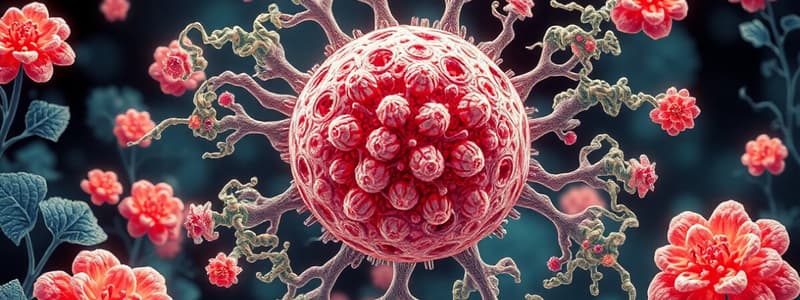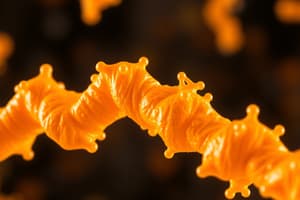Podcast
Questions and Answers
Which route of introduction is least likely to increase immunogenicity?
Which route of introduction is least likely to increase immunogenicity?
- Intraperitoneal injection
- Subcutaneous injection
- Intravenous injection (correct)
- Intragastric administration (correct)
What amount of protein is associated with increased immunogenicity?
What amount of protein is associated with increased immunogenicity?
- Moderate (intermediate) amounts of protein (correct)
- Very low amounts of protein
- No protein at all
- Very high amounts of protein
What characterization of proteins is associated with decreased immunogenicity?
What characterization of proteins is associated with decreased immunogenicity?
- Denatured proteins
- Complex proteins
- Proteins that interact effectively with MHC
- Simple proteins (correct)
Under which condition do proteins have increased immunogenicity related to their form?
Under which condition do proteins have increased immunogenicity related to their form?
How does similarity to self proteins affect immunogenicity?
How does similarity to self proteins affect immunogenicity?
Which condition regarding adjuvants is associated with decreased immunogenicity?
Which condition regarding adjuvants is associated with decreased immunogenicity?
Which of the following antigens is considered highly immunogenic?
Which of the following antigens is considered highly immunogenic?
What structural types of antigens can elicit an immune response?
What structural types of antigens can elicit an immune response?
What is the primary difference between an immunogen and an antigen?
What is the primary difference between an immunogen and an antigen?
Which size of antigens typically triggers a stronger immune response?
Which size of antigens typically triggers a stronger immune response?
What is an example of a substance that acts as an antigen but is not an immunogen?
What is an example of a substance that acts as an antigen but is not an immunogen?
Which factor does NOT affect the immunogenicity of an antigen?
Which factor does NOT affect the immunogenicity of an antigen?
What defines an immunogen in terms of its interaction with the immune system?
What defines an immunogen in terms of its interaction with the immune system?
Why might a small molecule function as an antigen?
Why might a small molecule function as an antigen?
Which of the following statements about antigens is true?
Which of the following statements about antigens is true?
How does the dosage and route of an antigen affect immunogenicity?
How does the dosage and route of an antigen affect immunogenicity?
What is the primary mechanism by which superantigens activate T cells?
What is the primary mechanism by which superantigens activate T cells?
Which of the following is NOT a consequence of superantigen activation of T cells?
Which of the following is NOT a consequence of superantigen activation of T cells?
What characteristic of haptens prevents them from eliciting an immune response on their own?
What characteristic of haptens prevents them from eliciting an immune response on their own?
Superantigens can lead to which of the following severe clinical outcomes?
Superantigens can lead to which of the following severe clinical outcomes?
How do haptens become immunogenic?
How do haptens become immunogenic?
Which superantigen is commonly associated with toxic shock syndrome?
Which superantigen is commonly associated with toxic shock syndrome?
What type of immune response is triggered by the activation of T cells through superantigens?
What type of immune response is triggered by the activation of T cells through superantigens?
What is a common characteristic of small molecules categorized as haptens?
What is a common characteristic of small molecules categorized as haptens?
What is necessary for a peptide to effectively induce an immune response?
What is necessary for a peptide to effectively induce an immune response?
What defines an exogenous antigen?
What defines an exogenous antigen?
What is an epitope?
What is an epitope?
What characterizes autoantigens?
What characterizes autoantigens?
What distinguishes tumor-specific antigens (TSAs)?
What distinguishes tumor-specific antigens (TSAs)?
How are superantigens unique?
How are superantigens unique?
What is the valency of an antigen?
What is the valency of an antigen?
How can an epitope be expressed differently?
How can an epitope be expressed differently?
Flashcards are hidden until you start studying
Study Notes
Immunogen vs. Antigen
- An immunogen induces an immune response, while an antigen binds to specific antibodies.
- Immunogens are typically larger and more complex than antigens.
- All immunogens are antigens, but not all antigens are immunogens.
Features that determine immunogenicity
- Recognition of foreignness: The immune system responds to substances that are not part of the body.
- Size: Larger antigens (over 10,000 Daltons) tend to elicit stronger immune responses.
- Chemical and structural complexity: More complex antigens trigger stronger immune responses.
- Genetic constitution of the host: Individuals with different genes may respond differently to the same antigen.
- Dosage, route, and timing: The amount of antigen, the way it enters the body, and the timing of administration affect immune response strength.
Factors that increase or decrease immunogenicity
- Size: Larger proteins are more immunogenic than smaller ones.
- Dose: Moderate amounts of protein are more immunogenic than very high or very low amounts.
- Route: Subcutaneous or intraperitoneal injections are more immunogenic than intravenous or intragastric administration.
- Composition: Complex proteins are more immunogenic than simple proteins.
- Form: Particulate or denatured proteins are more immunogenic than soluble or native proteins.
- Similarity to self-proteins: Proteins that are very different from the body’s own proteins are more immunogenic.
- Adjuvants: Slow protein release or the presence of bacteria enhance immunogenicity.
- Interaction with MHC: Effective interaction with MHC molecules increases immunogenicity.
Classification of Antigens based on Chemical Nature (Structural)
- Proteins: Major type, highly immunogenic (e.g., enzymes, structural proteins).
- Polysaccharides: Often found on the surface of bacteria (e.g., capsular polysaccharides).
- Lipids and nucleic acids: Less immunogenic, but can elicit responses in certain contexts.
Classification of Antigens based on Origin
- Exogenous antigens: Come from outside the body (e.g., pathogens).
- Endogenous antigens: Originate from within the body (e.g., cancer cells, autoantigens).
Epitope
- Antigenic determinant: Small, specific region of an antigen recognized by an antibody.
- Size: Typically 4-5 amino acids or monosaccharides.
- Types:
- Topographical: Located on the surface of the antigen.
- Internal: Exposed after processing by antigen-presenting cells (APCs).
- Valency: Number of epitopes on an antigen (can vary from one to hundreds).
- Configuration: The shape of an epitope can be altered by interactions with other substances.
Autoantigens
- Normal proteins/protein complexes: Recognized by the immune system in autoimmune diseases.
- Loss of immune tolerance: Autoantigens are normally not targeted by the immune system, but tolerance may be lost due to genetic and environmental factors.
Tumor Antigens
- Presented by MHC I on the surface of tumor cells.
- Tumor-specific antigens (TSAs): Presented only by tumor cells, often the result of mutations.
Superantigens
- Trigger intense immune responses by activating large numbers of T cells.
- Bind directly to MHC class II molecules and T cell receptors (TCRs) outside of the conventional antigen-binding site.
- Activate up to 20% of T cells, leading to massive cytokine release.
- Examples: Staphylococcal enterotoxins (SEs), Toxic shock syndrome toxin-1 (TSST-1).
Superantigen Mechanism of Action
- Binding to MHC and TCR: Bypass the need for antigen processing and activate T cells directly.
- Massive T cell activation: Lead to activation of a larger proportion of T cells than conventional antigens.
- Cytokine release: Release of pro-inflammatory cytokines (IL-2, TNF-α), causing systemic inflammatory responses, toxic shock syndrome, and autoimmune reactions.
- Potential for immunopathology: Can cause tissue and organ damage, leading to severe clinical manifestations.
Haptens
- Small molecules that are not immunogenic on their own.
- Become immunogenic when combined with carrier proteins, forming a complete antigenic structure.
- Characteristics:
- Low molecular weight (usually < 1000 Da).
- Derived from various chemical structures (e.g., small organic molecules, peptides, drug metabolites).
- Example: Penicillin.
Studying That Suits You
Use AI to generate personalized quizzes and flashcards to suit your learning preferences.





